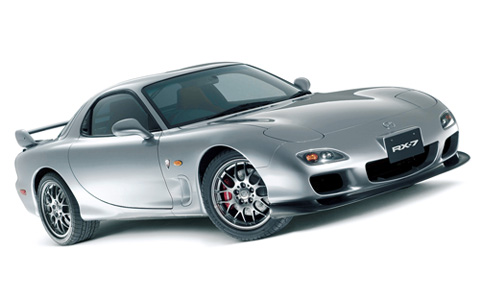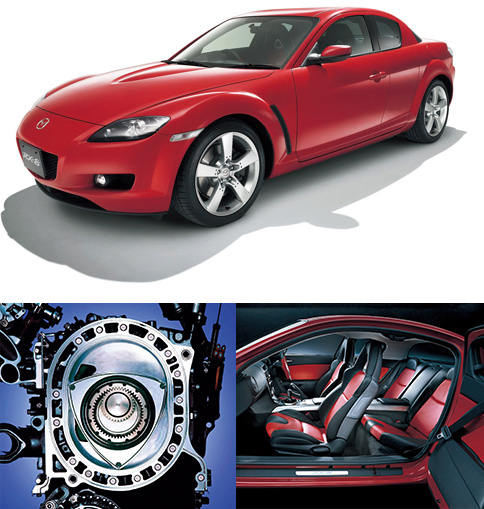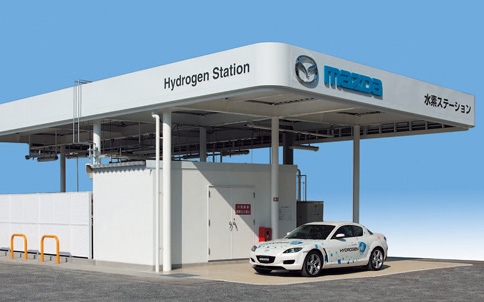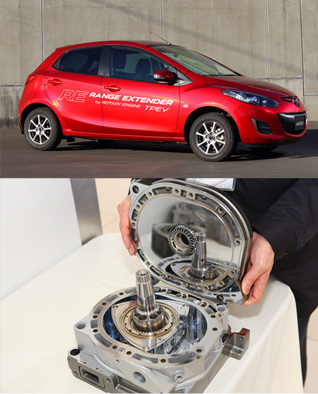Chapter III
Entering a New Era and Looking Further into the Future
In 1991, Mazda was basking in the sunshine of glory due to the landmark victory in the Le Mans race and took a big step forward with the launch of the FD RX-7, a rotary engine-powered sports car, but a dark cloud was forming on the horizon. In Japan, Mazda’s home market, the economic bubble burst and the ensuing recession, coupled with the effects of the yen’s rise, chilled demand for sports cars. At that time, in a bid to improve fuel efficiency, Mazda was stepping up efforts to develop a side exhaust port system, which would provide an excellent sense of acceleration typical of a naturally aspirated engine while maintaining the rotary engine’s high power. In 1996, Mazda formally kicked off a project to develop a side exhaust port system for its next-generation rotary engine. Just as the development team was working to increase the power of this new engine, Mazda was forced to pull the plug on production of the FD RX-7 in 2002 due to an economic downturn. As a result, production of rotary engines was suspended, at least for the moment.

FD RX-7

upper: RX-8, whose production started in 2003
lower left: RENESIS fitted with a side exhaust port system
lower right: A four-door, four-seater fitted with free-style doors
Nevertheless, the development team continued their effort toward future development and mass production of a new rotary engine. In particular, creating the side exhaust port system was a huge challenge that even the veteran engineers, Mazda’s legendary samurai, were unable to surmount. However, in 2003, the team developed the RENESIS new rotary engine, after overcoming a number of technical problems with perseverance. We coined RENESIS by combining “RE” (as in “restart”) and “NESIS” (the last part of the word “genesis)” to signal a brand new start for the rotary engine. Boasting high power despite natural respiration and dramatic improvement in fuel efficiency and exhaust gas cleanness, the RENESIS engine appeared to presage a new dawn for the rotary engine. In 2003, production of the rotary engine-powered RX-8 came on stream. By taking the rotary engine’s winning combination of small size, light weight and high performance to the next level, the RENESIS engine made it possible to realize the RX-8’s whole new concept – a full-fledged sports car with a four-door, four-seater configuration. The arrival of the RX-8 ushered in the renaissance of the rotary engine.
As far back as the early 1990s, hydrogen fuel had already been expected to become important when considering how to make cars friendly to the earth and human beings. Mazda moved step by step toward commercialization of a hydrogen rotary engine-powered vehicle through a series of improvements. In the 1991 motor shows, Mazda displayed a hydrogen rotary engine and the HR-X concept car powered by it. Also, a prototype MX-5 fitted with a hydrogen rotary engine was built. Mazda started public road testing of a hydrogen rotary engine-powered car in 1995. In 2003, it rolled out the RX-8 Hydrogen RE, the world’s first practical hydrogen rotary engine-powered car. The RX-8 Hydrogen RE is a highly practical car thanks to its adoption of a dual fuel system. It combines clean performance and driving comfort. The development of the RX-8 Hydrogen RE paved the way for future generations of hydrogen rotary engines. In 2006, Mazda became the world’s first company to launch practical use of a hydrogen rotary engine-powered car through a leasing arrangement.

RX-8 Hydrogen RE and a hydrogen station

upper:Demio EV fitted with a range extender
lower:A small rotary engine unit used as a range extender
What’s more, Mazda is studying ways of using rotary engine technology to extend the driving range of electric cars. We believe that we can push the rotary engine’s advantages – small size, light weight, high power and quietness – to the maximum in the field of electric cars. The new Demio EV, which premiered in November 2013, has a driving range of 400 kilometers, double that of its predecessor, an improvement made possible by installing a rotary engine range extender under the trunk space. In the future, the use of a range extender, coupled with our expertise in the hydrogen rotary engine, may be applied to mobile power generation equipment using alternative fuels such as gas.
As shown above, the rotary engine has a huge potential for combining outstanding driving and environmental performance. Given its compatibility with multiple types of fuel, including hydrogen, and adaptability to power generation use, the rotary engine’s potential as an environment-friendly engine is high. We will continue research and development of the rotary engine as our unique technology in pursuit of its further potential. Driven by Mazda’s willingness to take on challenges, the wheel of our rotary engine history will continue to turn.

